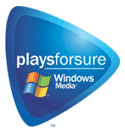
Microsoft PlaysForSure was a certification given by Microsoft to portable devices and content services that had been tested against several hundred compatibility and performance requirements. These requirements include codec support, digital rights management support, UI responsiveness, device performance, compatibility with Windows Media Player, synchronization performance, and so on. PlaysForSure certification was available for portable media players, network-attached digital media receivers, and media-enabled mobile phones. The PlaysForSure logo was applied to device packaging as well as to online music stores and online video stores.
Contents
- Overview
- Content providers that offered PlaysForSure-certified content
- Hardware vendors that support PlaysForSure-certified media
- Software that can stream media to PlaysForSure devices
- Criticisms
- See also
- References
- External links
PlaysForSure was introduced in 2004. [1] In 2007, Microsoft rebranded and scaled back "PlaysForSure" [2] [3] into the subset Certified for Windows Vista. [4]
Microsoft's Zune worked only with its own content service called Zune Marketplace, not PlaysForSure. The Zune and PlaysForSure music were both Certified for Windows Vista, yet the Zune could not play PlaysForSure music purchased from the MSN Music store. [5]
Microsoft announced that as of August 31, 2008, PlaysForSure content from their retired MSN Music store would need to be licensed to play before this date[ when? ] or burned permanently to CD, [6] although this decision was later reversed. [7] With the exception of Windows Media Player, all of the PlaysForSure offerings were made or run by 3rd-party companies, while Microsoft's Entertainment and Devices Division developed and marketed the Zune.